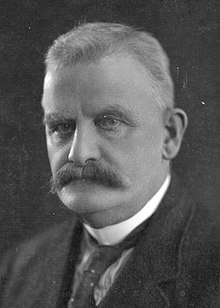|
John Barnes (Australian politician)
John Barnes (17 July 1868 – 31 January 1938) was an Australian trade unionist and politician. He was a member of the Australian Labor Party (ALP) and served as a Senator for Victoria from 1913 to 1920 and 1923 to 1935. He was his party's Senate leader from 1931 to 1935 and served as Vice-President of the Executive Council in the Scullin government from 1931 to 1932. Early lifeBarnes was born on 17 July 1868 in Hamilton, South Australia. He was the son of Mary (née Cummeford) and John Thomas Barnes. His father was a labourer originally from Somerset, England, while his mother was from County Clare, Ireland.[1] Barnes' father died when he was six years old and he had a limited formal education. He left school at a young age and worked a variety of jobs, including as a roustabout, timber-getter and handyman. While travelling in search of work he lived out of a swag, reputedly carrying the works of Adam Smith, Henry George, Robert Blatchford and Henry Lawson with him.[2] Barnes eventually began working in shearing sheds, initially as a shed hand and "tar boy" and then as a shearer. By the late 1880s he had settled in Broken Hill, New South Wales, where he joined the Amalgamated Shearers' Union in 1887. He also worked as a miner for a period.[1] Union movementIn 1894, Barnes was involved in the merger of the Amalgamated Shearers' Union into the new Australian Workers' Union (AWU).[1] He was the first AWU agent in Broken Hill and later returned to South Australia where he was the AWU's first paid organiser.[2] Barnes later served as the secretary of the AWU's Victoria/Riverina division from 1909 to 1913, based in Ballarat. He was elected federal president of the AWU in 1923, a position he would hold until his death in 1938.[1] Politics Barnes was first elected to the Senate at the 1913 federal election, winning a six-year term beginning on 1 July 1913. His initial term was cut short by a double dissolution, but he was re-elected to a further six-year term at the 1914 election.[3] Barnes was defeated at the 1919 general election but was again elected in 1922 and in 1928. He was Assistant Minister for Works and Railways from 22 October 1929 to 3 March 1931 and then Vice-President of the Executive Council and Leader of the Government in the Senate until 6 January 1932. He was then Leader of the Opposition in the Senate until 30 June 1935. Though he held his seat until this date, he had been defeated at the general election held in 1934. He was re-elected to the Senate in 1937, his term due to begin on 1 July 1938.[4][5] Late life and legacyBarnes, however was suffering from cancer and died in East Melbourne on 31 January 1938 as a senator-elect. He left a widow, one son and five daughters. He was given a state funeral, the procession travelling through the city, pausing at Trades Hall, and continuing to the Melbourne General Cemetery.[4][2] Barnes, at the time, was the most notorious practical joker in Australian federal politics. His sense of humour went along with earnestness and a belief in the cause of Labour. He was well regarded amongst colleagues and in union circles, where he was for many years a leader before entering politics.[4] References
|
||||||||||||||||||||||||||||||||||||||||||
